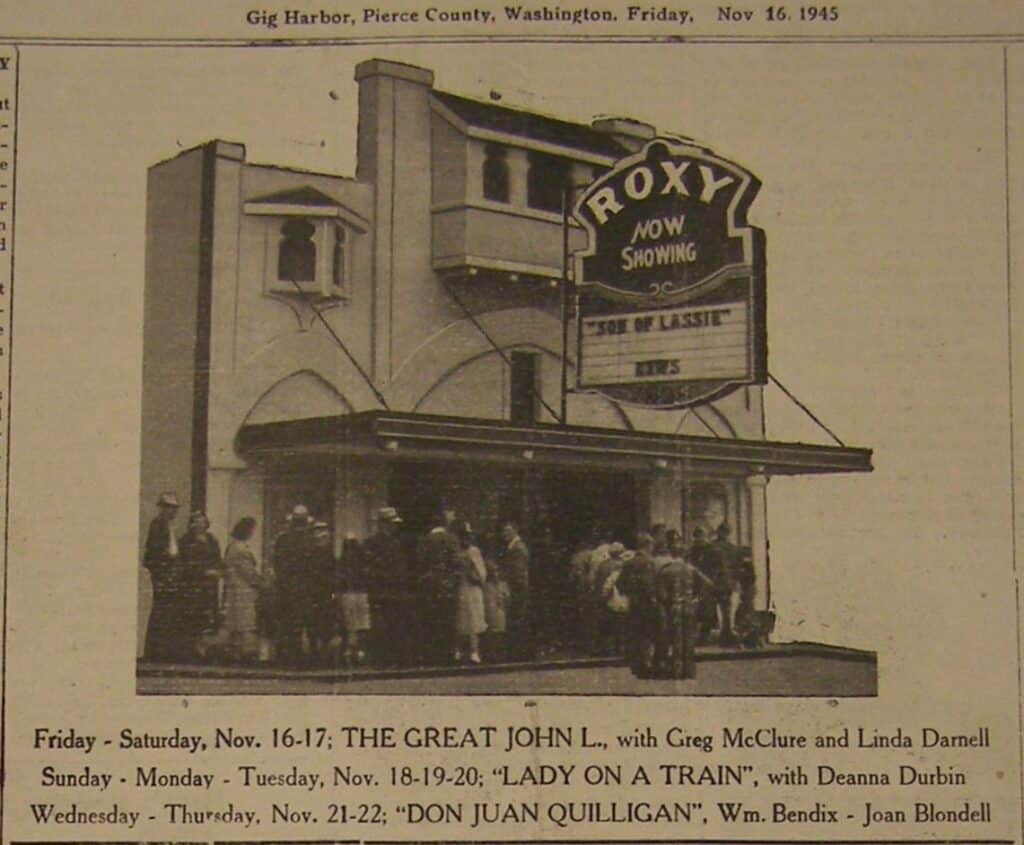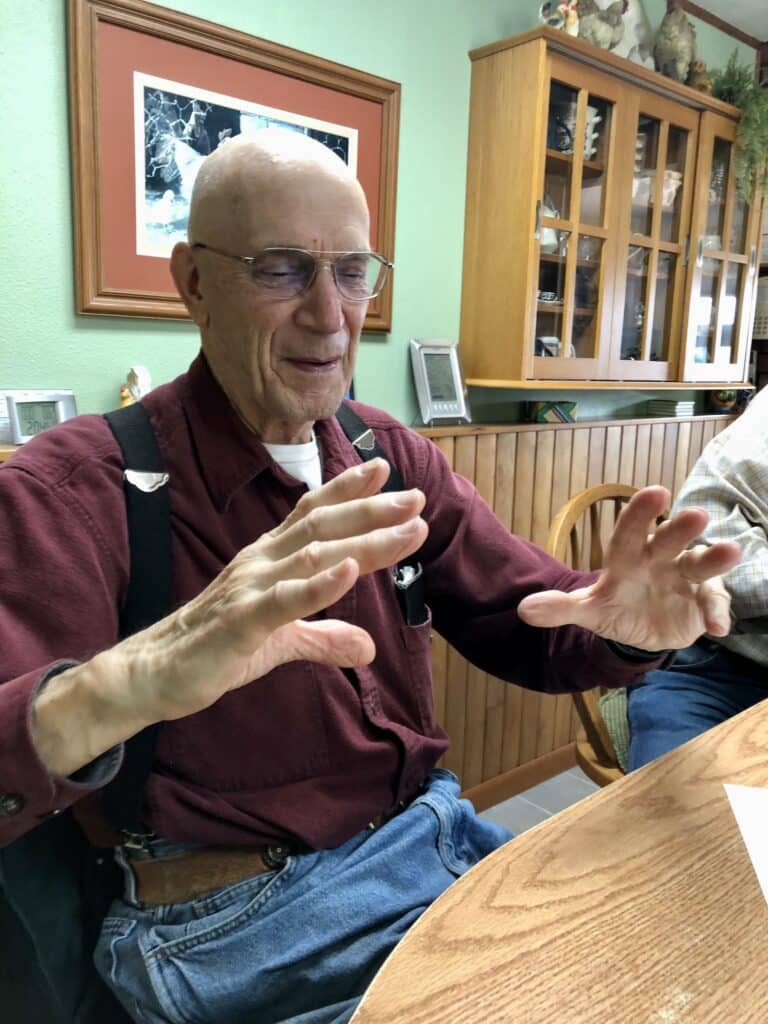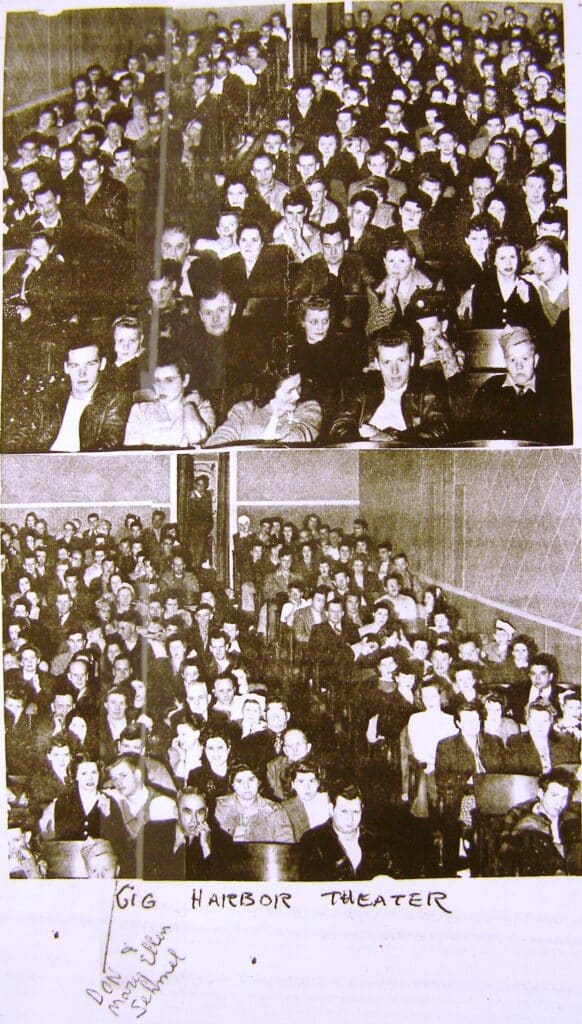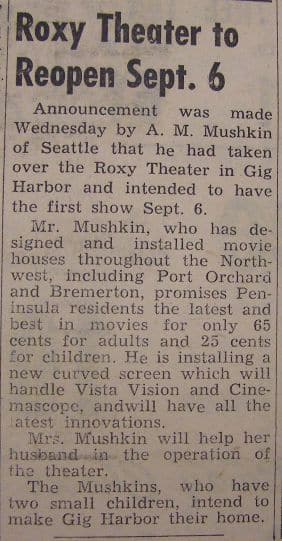Arts & Entertainment Business Community
Rosedale man beamed final movie at downtown theater
There once was a theater in downtown Gig Harbor. A high school kid shut down the projectors for the final time in 1958. Now 83, Jim Langhelm remembers it well.
Arts & Entertainment Sponsor
Arts & Entertainment stories are made possible in part by the Gig Harbor Film Festival, a proud sponsor of Gig Harbor Now.
Known as the Roxy for most of its life, the movie house began in 1925 as the stucco, Spanish-style Empress Theatre, and had a few other names in between. It stood on Harborview Drive, abutting what is now the Heritage Distilling tasting room.
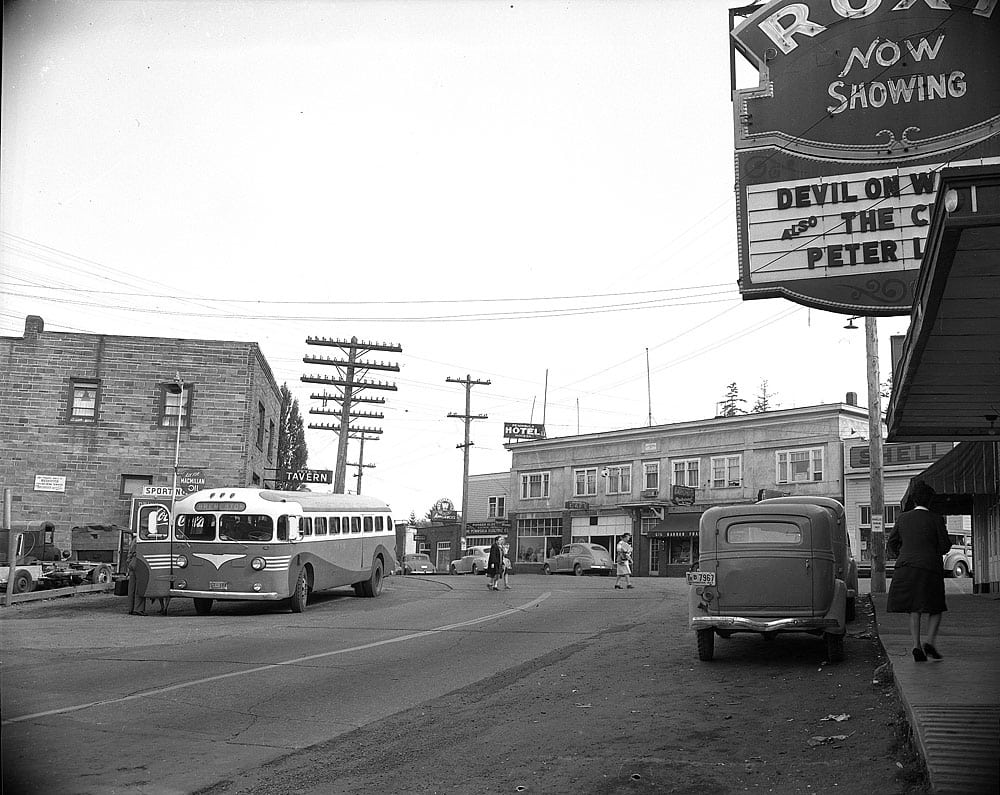
Harborview Drive in Gig Harbor in 1947. On the left is a Bremerton-bound bus and Pete’s Tavern. In the distance are Pioneer Electric, Peninsula Hotel and Cafe. On the right is the Roxy Theatre featuring “Devil on Wheels.” Photo courtesy Washington State Historical Society
Walked to movies as a young kid
Langhelm first became acquainted with the Roxy as a youngster growing up in Shore Acres, down the hill from what’s now the Olympic Village Shopping Center. On summer weekends, he and cousin Ron Spadoni, 6 and 8 years old, glided 1½ miles down Soundview Drive to the evening movies, then climbed back up at 10:30 p.m. In the late 1940s, nobody worried.
“It might’ve been ‘Lassie Come Home’ or one of those Lassie movies,” Langhelm said of his first show.
Fast forward to fall 1957. The Langhelm family has moved to Rosedale. Jim is now a senior at Peninsula High School. The Roxy is struggling through another closure.
Roxy reopened in 1957
Seattle businessman Al Mushkin, searching for a tax write-off, decides to operate the theater Friday and Saturday nights only.
The Peninsula Gateway wrote on Aug. 22, 1957, that Mushkin had “taken over the Roxy Theater in Gig Harbor and intended to have the first show Sept. 6.” Mushkin, the story stated, had designed and installed movie houses throughout the Northwest, including Port Orchard and Bremerton, and “promises Peninsula residents the latest and best in movies for only 65 cents for adults and 25 cents for children.”
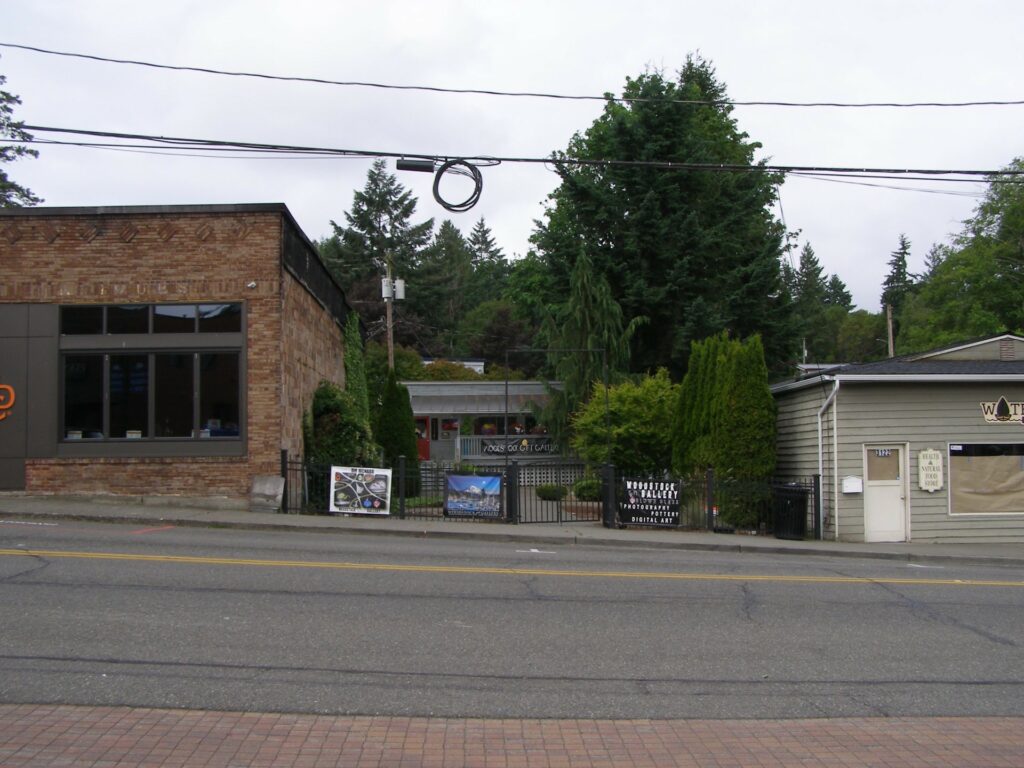
A street view today of where they theater was located on Harborview Drive, between the Heritage Distilling tasting room and the former health food store. Photo by Greg Spadoni
Mushkin hired Jim’s uncle, Rudolph “Rudy” Spadoni, to run the projectors and a cousin, Gloria Spadoni, to sell tickets. Within a month, Rudy, co-owner of Spadoni Brothers Inc., tired of the side job and pitched it to Jim, who he’d seen in action that summer driving dump trucks for the construction company.
Teen Langhelm offered job
“I said, ‘Wow, that sounds interesting,’” Langhelm recalled last week during an interview at the Rosedale home where he lived then and again now with Hallie, his wife of 56 years.
Rudy spent a few weekends in the projection booth training Langhelm, then promised to stay near a phone for the next several weeks in case of an emergency.
“Although I had a few exciting moments during the first few weeks on my own, I was able to handle the situation myself and never had to make that call for his help,” Langhelm said.
Was next to Heritage building
The theater was shoebox-shaped and shoehorned between what is now the Heritage building and was most recently Waterfront Natural Market. After the Roxy was torn down in 1964, the lot largely remained open except for a structure at the back that long housed Wild Birds Unlimited and now Woodstock Gift Gallery.
Across the street where Windermere Real Estate is now located was Pete’s Tavern.
“Early in to running the theater, I was concerned about drunks coming across, but they never did,” Langhelm said.
Langhelm’s worst audience experience occurred when kids threw small objects up in front of the movie projector light beam that initially looked like lit matches.
“I shut the projectors down, turned on the house lights. I didn’t know who it was (because it was dark),” he said. “I said leave or don’t throw any more because the next match that goes up, I’m closing it down and we’re done for the night.”
Roxy layout
Langhelm, seated at his dining room table, sketched out the theater layout on a sheet of paper. A marquee with the lighted Roxy sign and movie titles hung over the sidewalk and provided shelter for ticket buyers. The ticket booth sat in the middle, separating entrance and exit doors.
Customers stepped inside to a foyer with a concession stand to the right. In the auditorium, two aisles curved down to the stage. Each row had two or three flip-up seats on the wall sides and about 10 in between. Capacity was about 200, Langhelm estimated.
A spiral staircase led to the projection room above the lobby, where Langhelm juggled rods and reels. The theater showed a cartoon, previews and two 1½-hour main features, mostly family movies mixed with a few spooky ones. Each reel lasted just 20 minutes, so Langhelm jumped between side-by-side projectors. While one was running film, the next reel was readied in the other.
“I always changed reels on a scene change so spectators had no idea what was going on,” Langhelm said.
Rods and reels
Back then, carbon arcs were the only light source bright enough to fill the screen. The light was created by two carbon rods with a small gap between them. When electricity was passed between the 12-inch rods, the ionization of the air created a bright “arc” of light. The rods needed to be constantly adjusted as they burned down to maintain a consistent gap. They only lasted two to three reels, so Langhelm had to replace them several times a night in each projector.
“It was always a challenge to burn it down to the shortest piece possible, and it was hot,” he said.
Operating the projectors could be tricky, particularly if the film broke, which only happened a few times. It wasn’t especially difficult once Langhelm got the hang of it.
“I was not very busy at all,” he said. “It took five minutes at best to set up the next projector.”
Much of Langhelm’s time was spent standing between the projectors peering at the screen through an 18-inch-square opening to assure the movie appeared as it should.
Good pay
Mushkin paid him at least $15 to $20 in cash per weekend, which would be $159 to $213 today, an amount Langhelm felt deserving because, “I was giving up my senior year of social life.”
Langhelm briefly considered exploiting his newfound cinematic proficiency.
“It was something when I was well into it that I thought this would be a very interesting job to have,” he said. “I could take this experience with the Roxy and go run projectors at other movie theaters because it really was easy money.”
Instead, he continued studies at Olympic (Community) College in Bremerton and Tacoma Vocational School (now Bates Technical College). He served a welding apprenticeship at Puget Sound Naval Shipyard in Bremerton and worked there from 1961 until 1995 minus a two-year Army stint.
Langhelm remained at the Roxy right up until the day it closed in October 1958. He didn’t grab any mementos on his way out the door.
“Nothing but memories, and lots of ‘em,” he said.
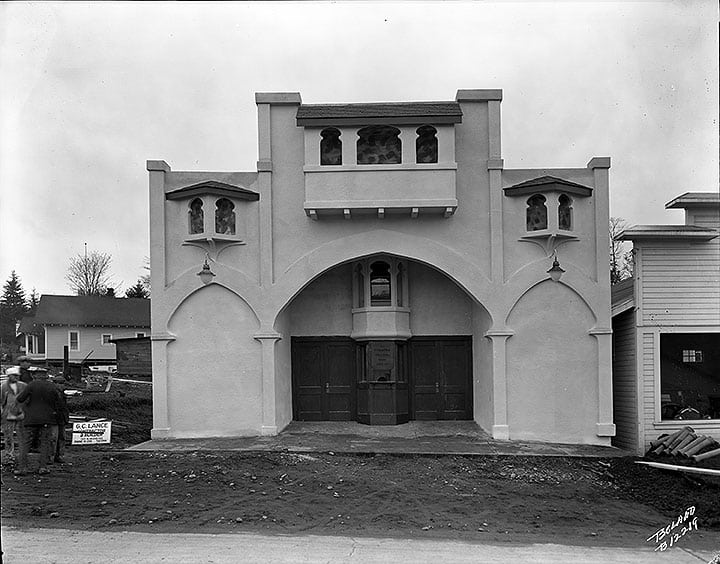
The downtown Gig Harbor movie house was originally known as the Empress Theater. Photo courtesy Washington State Historical Society


